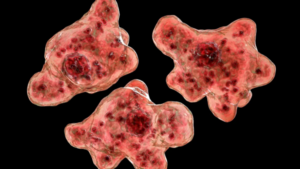Naegleria Fowleri
Ron Smith, MD
Naegleria Fowleri in the News
This photomicrograph of a brain tissue specimen depicts the cytoarchitectural changes associated with a free-living amebic infection, which may have been caused by either a Naegleria fowleri, or an Acanthamoeba sp. organism. These organisms were found in the brain of a Japanese Prisoner of war in the 1950’s, before we knew about the free living amebae, and how they attack the brain.

 Once within the brain, it kills brain tissue, causing symptoms similar to bacterial meningitis, such as migraine, fever, stiff neck, and disorientation. Patients experience loss of concentration, convulsions, and coma, and the sickness generally kills them within five days after the commencement of symptoms. Only four of the 154 individuals known to have been affected by the bacterium since 1962 have survived.
Once within the brain, it kills brain tissue, causing symptoms similar to bacterial meningitis, such as migraine, fever, stiff neck, and disorientation. Patients experience loss of concentration, convulsions, and coma, and the sickness generally kills them within five days after the commencement of symptoms. Only four of the 154 individuals known to have been affected by the bacterium since 1962 have survived.